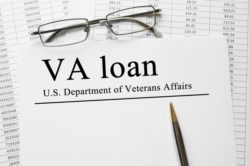The VA loan, which makes homeownership more easily attainable for thousands of veterans, is one of the most popular military benefits. After you purchase a home with a VA loan, you may want to reduce your monthly mortgage payments or change how you pay off the home.
You can sometimes lower your monthly VA loan payment by refinancing it at a lower interest rate or by changing from an adjustable-rate to a fixed-rate loan. Whatever the reason for refinancing your VA mortgage, you should consider the pros and cons as they apply to your situation.
Table of Contents
- Should You Refinance a VA Mortgage?
- Has Your Credit Score Improved?
- Are VA Mortgage Interest Rates Increasing?
- Are You Having Trouble Making Your Payments?
- Do You Need to Consolidate Other Debts?
- Are You Making More Money?
- Pros of Refinancing a VA Loan
- Cons of Refinancing a VA Loan
- Ways to Refinance Your VA Loan
- When Can I Refinance With the VA Loan?
- Mortgage Refinance Mistakes
Should You Refinance a VA Mortgage?
While refinancing has many potential benefits, refinance your VA mortgage is not always a good idea. If you’re considering a refinance, here are a few things to consider:
Has Your Credit Score Improved?
Because your mortgage interest rate is determined partially based on your FICO credit score, if you know your credit score has improved considerably since your mortgage loan was signed, it makes sense to consider refinancing your mortgage. The improved credit score should offer a better interest rate. The good news is that being approved for a mortgage can improve your credit score over time, as long as you make regular payments.
If your credit score has decreased since closing on your VA loan, it may not be a good idea to refinance since you risk potentially less favorable terms.
Are VA Mortgage Interest Rates Increasing?
Refinancing into a lower interest rate with a VA streamline refinance is a great option if the current rate is lower than when you closed on your loan. Or, if you currently have an adjustable-rate mortgage (ARM) and anticipate increasing interest rates, you’ll want to try and switch to a fixed-rate mortgage.
When you have a fixed-rate mortgage, your interest rate will stay the same throughout the loan, unless you refinance it again later. If you already have a fixed-rate mortgage and interest rates are increasing, you probably will not want to refinance.
Sometimes people refinance despite getting a higher interest rate if they need to take equity out of their home by using a VA cashout refinance or change the term of the loan – maybe from 30 years to 15 years so that they can pay it off faster.
Click here to check VA Mortgage Rates in your area.
Are You Having Trouble Making Your Payments?
If you’re struggling to make ends meet, it may be a good idea to refinance your mortgage if you can lower the interest rate or monthly payment amount. This can be done by refinancing the remaining balance on your mortgage loan to a new 30-year loan. The lower balance and a longer repayment term will reduce your monthly payments. If you qualify for a lower interest rate, you can decrease your monthly payment even more.
Do You Need to Consolidate Other Debts?
If you find your credit cards or loan payments have gotten out of control, you may decide to take some of the equity out of your home to pay off those debts. You can extract equity from your home with a VA cashout refinance. Once you have used the home’s equity to pay off debts, you’ll just have one payment for your home each month to worry about. You’ll save money on interest payments, and it makes it easier to keep track of payments.
Are You Making More Money?
Not all mortgage refinances are done to obtain a lower payment. Sometimes, people get a higher-paying job or get married and then have a two-income earning family. Suppose you put your higher income toward paying off your mortgage sooner. In that case, you may decide to refinance the mortgage to a 15-year term rather than a 30-year. You’ll save tens of thousands of dollars in interest and own your home free and clear that much sooner.
Pros of Refinancing a VA Loan
Most people refinance due to three primary factors: lower interest rate, lower monthly payment, and access to cash.
An interest rate dropping from, say, 6% down to 3.5% is certainly attractive, potentially saving $200 or $300 per month on your house payment.
Additionally, many VA borrowers may be interested in tapping into their home equity with a VA cashout refinance. Veterans can use these funds towards home improvements, paying off debts, going on vacation and so on. There is no limit to how you can use the funds you receive from your home equity.
Cons of Refinancing a VA Loan
There are some cons involved in refinancing your home that homeowners are not always aware of. This isn’t to say that you shouldn’t refinance your VA loan, only that you need to be aware of certain realities. Let’s examine some of the potential cons of refinancing your VA loan.
Closing Costs
Closing costs are the most prominent and easily measurable costs in a refinance. Just like you had to with your VA purchase loan, you’ll also need to pay the VA funding fee after refinancing unless you are exempt.
One of the most popular ways to determine if the closing costs paid justify the refinance is by dividing the amount of the closing costs by the monthly savings. This is sometimes referred to as the “recapture period”. For example, if you divide $3,000 in closing costs by a $200 per month reduction in your house payment, you will see that the refinance will pay for itself in just 15 months.
Most financial experts will say that a VA refinance is worth doing if you can recover your closing costs in 24 to 36 months. This is especially true if you plan on being in the house for five years or longer. Not only will you recover the closing costs paid within the first two or three years, but you’ll reap real savings in every year thereafter.
VA Refinance Funding Fee
Another consideration you’ll need to make is how the VA funding fee plays into your refinance. Here’s the breakdown for both IRRRL and cash-out refinances:
| VA Refinance Type | Funding Fee for First VA Loan | Funding Fee for Second VA Loan |
| IRRRL (Streamline) | 0.5% | 0.5% |
| Cash-Out Refinance | 2.15% | 3.3% |

Check your VA Home Loan eligibility and get personalized rates. Answer a few questions and we'll connect you with a trusted VA lender to answer any questions you have about the VA loan program.
Ways to Refinance Your VA Loan
VA Interest Rate Reduction Refinance Loan
The Interest Rate Reduction Refinance Loan, or IRRRL, is for those who want to refinance an existing VA loan into a new VA loan. A VA IRRRL is also commonly referred to as a streamline refinance, because the process is simplified so borrowers can close quickly.
To qualify for an IRRRL, the interest rate on your new loan must be lower than your original loan’s – but a lower interest is often why people choose to refinance. You can also use this VA refinance option to switch from an adjustable-rate mortgage to a fixed-rate mortage.
IRRRLs wrap closing costs into your new loan, saving you the up-front expense.
VA Cash-Out Refinance
A VA cash-out refinance also allows you to refinance into a VA loan from another VA loan or a conventional loan. It’s a great option for Veterans and service members who have not taken advantage of their VA benefit yet and don’t want to buy a new home to do so. A cash-out refinance also allows you to extract cash from the home’s equity to use toward a renovation, paying off debt or another financial goal.
Note: If you’re refinancing from a conventional loan to a VA loan, lenders will refer to it as a “cash-out refinance,” even if you don’t intend to pull equity out of the home. This is simply because you cannot use a VA streamline refinance with a conventional loan. You are not required to take out any cash when using a cash-out refinance.
Remember that the property you wish to refinance with a VA loan must be your primary residence. Additionally, unlike the IRRRL, you cannot wrap closing costs into your loan with a cash-out refinance.
When Can I Refinance With the VA Loan?
The VA requires you to wait at least 210 days from your first loan payment on your original mortgage until you can close on your new VA refinance. This waiting period is known as “seasoning,” and it can vary by lender. Some lenders require 250 days between your first home loan payment and closing day for your VA refinance.
So, Should You Refinance Your VA Loan?
No matter what kind of mortgage you have, if the interest rates are at least a point lower now than they were when you obtained your loan, refinancing may be worth the time and effort.
Compare Today’s VA Home Loan Rates
VA Loan Rates
You could lower your monthly payments by refinancing for the same number of years as your original mortgage. However, this will extend how long you’ll be making payments and increase how much you’re paying in total interest over the course of your mortgage. Paying more than the monthly payment would allow you to repay your mortgage faster and reduce the total interest you pay.
If you have an ARM, you may find your interest rate is higher than current fixed mortgage rates. In this case, you will probably benefit greatly by refinancing your mortgage and getting a lower, fixed-interest rate.
If you have a first and second mortgage, refinancing into a single mortgage could consolidate your monthly bills, help you save money and make bill payments easier.
However, if you know you will be moving within a few years, refinancing may not make sense because you won’t have time to recoup the savings, especially if you add years to your mortgage.
Mortgage Refinance Mistakes
If you have a mortgage that is over a year old, chances are very good that you will be able to save money by refinancing your mortgage. But take some time to research your options before you apply for a new loan – and make sure you avoid these mistakes!
1. Be careful not to overestimate the value of your home. Home prices still haven’t fully stabilized in some areas of the country. You may not have as many refinancing options if you are underwater in your home, or you may need to apply for a special refinancing program, such as the Making Home Affordable program. Lower home prices may also erase some of your equity, meaning you may need to bring extra cash to the table to avoid PMI, or you may need to take out an 80-10-10 mortgage or other financing option.
2. Don’t focus only on the interest rates. Not all loans are created equally. Be sure to compare the offers from each lender on a term-by-term basis, keeping in mind that all lenders charge varying fees and closing costs. Compare lender fees, loan terms, and lender reputations to your decision to refinance your mortgage.
You may also be able to get a lower interest rate by buying points on your mortgage. Be sure to run the numbers.
3. Don’t use the first lender you find. There are thousands of lenders out there, but they aren’t all created equally. It’s a good idea to consider the lender’s reputation and whether or not your lender will continue to service your mortgage or sell it off to investors. Dealing with one lender over the course of your mortgage is often preferred over dealing with multiple mortgage servicers as sometimes paperwork gets lost, escrow requirements may change, etc.
Shop for the best mortgage rates. We recommend searching a variety of options before refinancing your mortgage. Some great places to shop for good mortgage rates include Quicken Loans and Lending Tree. We also have a mortgage comparison table on our site.
4. Consider all loan terms. Many borrowers are refinancing into a 30-year fixed mortgage instead of considering other options such as a 20-year or 15-year fixed rate, which would shorten the life of the loan and significantly reduce the amount paid to interest. Here are the pros and cons when comparing 15 and 30-year mortgages.
5. Consumers are uncertain of what documents are required to refinance: Borrowers who haven’t refinanced in recent years sometimes fail to have the required document going into refinancing which delays the closing process. Be sure to gather all your documentation in advance and bring it with you to the closing. This will save you a lot of time, and possibly money.
6. Inaction. The current mortgage rates are excellent, but they may or may not be around for a while. The sooner you lock in your rate, the sooner you can start saving money – and more importantly, not miss out on this opportunity.
7. Underestimating the time commitment. Refinancing your mortgage can be time intensive, depending on several factors, such as how much you owe on your home, whether or not there are multiple liens on the home, time of year, whether or not you are self-employed, and other factors. Be prepared to take a few days to compare mortgage rates, get your home appraised, and schedule the closing. The actual paperwork can take a couple of hours depending on all of the above factors. My wife and I used a VA Loan to buy our home, which has a specific process for buying and refinancing. Thankfully, refinancing with a VA Streamline Refinancewas fairly easy.
Take all of these items into account, and you can likely save a lot of money by refinancing your mortgage.




About the comments on this site:
These responses are not provided or commissioned by the bank advertiser. Responses have not been reviewed, approved or otherwise endorsed by the bank advertiser. It is not the bank advertiser’s responsibility to ensure all posts and/or questions are answered.